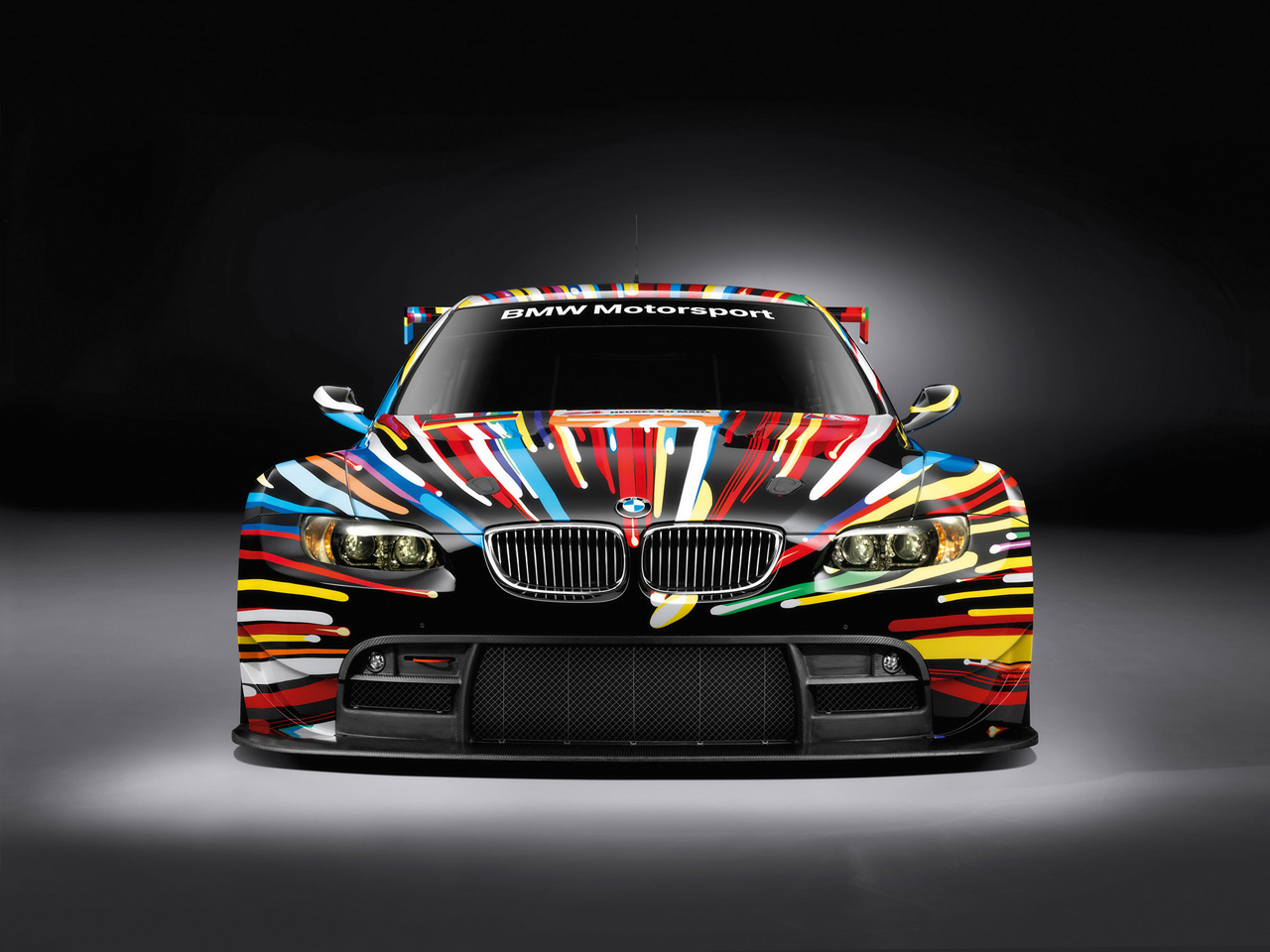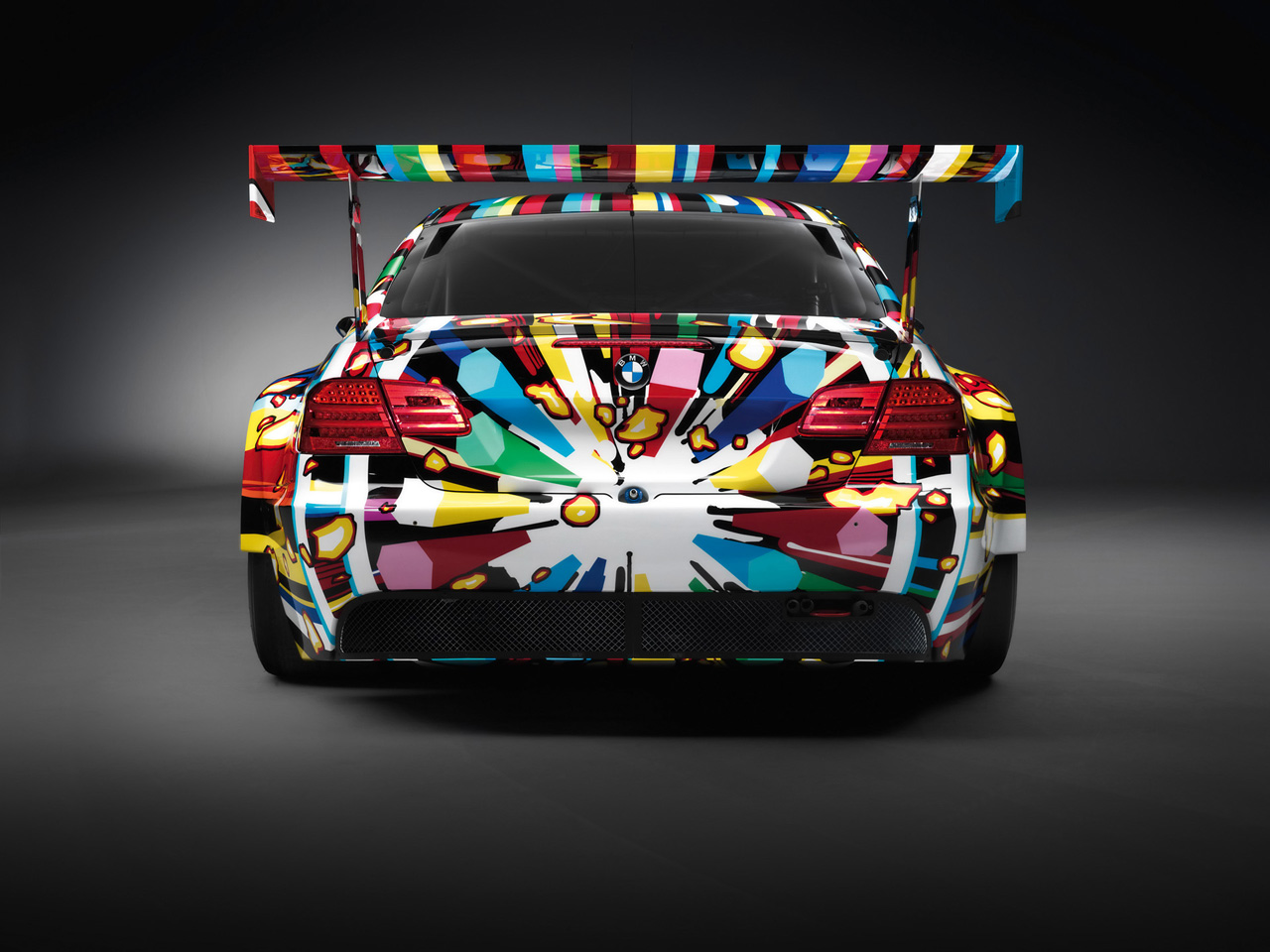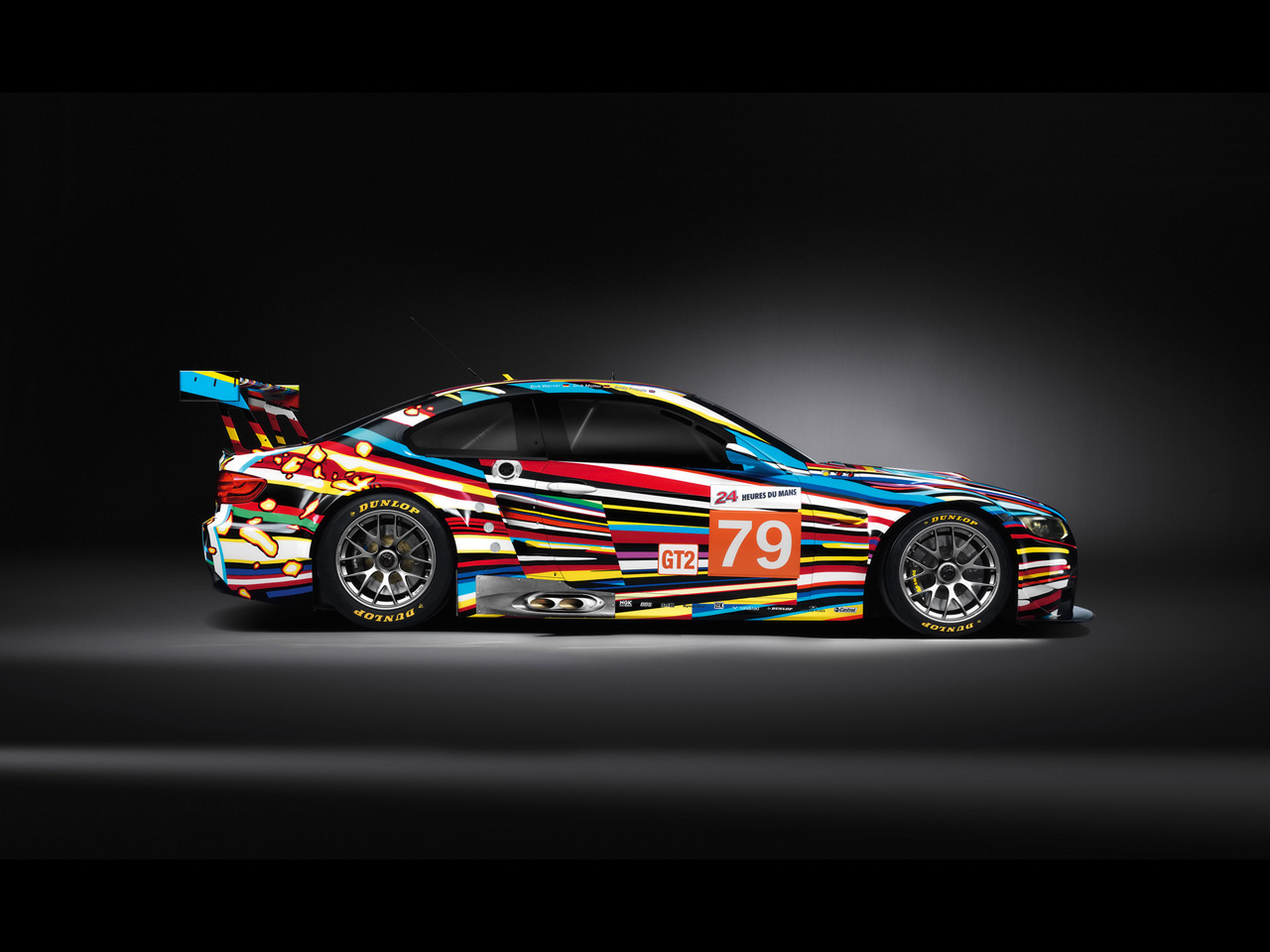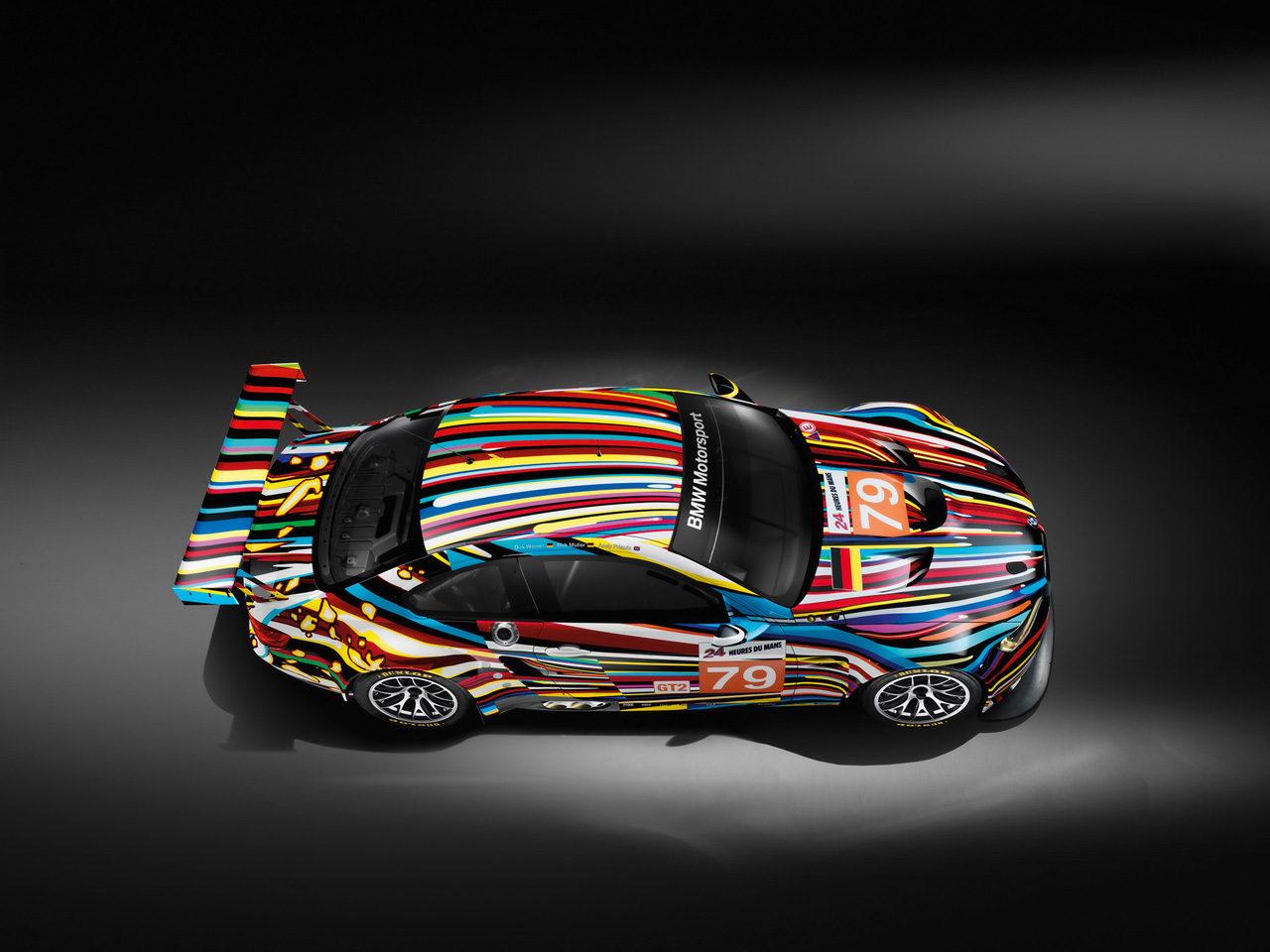2010 BMW M3 GT2 Art Car by Jeff Koons
|
Price |
-- |
Production |
-- | ||
|
Engine |
-- |
Weight |
-- | ||
|
Aspiration |
-- |
Torque |
-- | ||
|
HP |
-- |
HP/Weight |
-- | ||
|
HP/Liter |
-- |
1/4 mile |
-- | ||
|
0-62 mph |
-- |
Top Speed |
-- |
(from BMW Press
Release) World Premiere of Jeff Koons' BMW Art Car at the
Centre Pompidou in Paris. Car will race at 24 hours of Le Mans.
Paris. At the premiere of the 17th BMW Art Car Jeff Koons unveiled
and signed his car in front of 300 international VIP guests on June
1 in the Centre Pompidou, one of the world’s most prestigious
cultural institutions for modern and contemporary art. It is the
same place where Roy Lichtenstein back in 1977 first presented and
signed his Art Car.
In the spirit of Calder, Stella, Lichtenstein, Warhol, BMW announced
this year that the 17th Art Car created by Jeff Koons will race
where the first rolling pieces of art by legendary artists raced –
at the 24 Hours of Le Mans in France on June 12-13, 2010. Koons’
canvas is a BMW M3 GT2, which was homologated to compete at this
year’s running of the world’s most famous endurance race.
On June 2, between 11 am to 9 pm, the public will have the chance to
see the Art Car free of charge in the Forum of the Centre Pompidou.
At 5.30 pm Jeff Koons will participate in a book signing at the
official book store of the museum before he will talk about his work
in conversation with Alain Seban, President of the Centre Pompidou,
at 6 pm at the Forum of the museum.
The Design Process
As part of his creative
process, the artist collected images of race cars, related graphics,
vibrant colors, speed and explosions. The resulting artwork of
bright colors conceived by Koons is evocative of power, motion and
bursting energy. Its silver interior along with the powerful
exterior design, the Art Car will impart a dynamic appearance even
when it’s standing still.
“These race cars are like life, they are powerful and there is a lot
of energy,” said Koons. “You can participate with it, add to it and
let yourself transcend with its energy. There is a lot of power
under that hood and I want to let my ideas transcend with the car –
it’s really to connect with that power”.
Koons has been in an intense collaboration with BMW’s team in Munich
for months – melding his skill with sophisticated BMW engineering –
to ensure that the 17th BMW Art Car will be race-ready for the 24
Hours of Le Mans.
Traveling back and forth to Germany many times since the February 2
announcement that Koons would create the 17th BMW Art Car, the
artist has worked with the BMW engineering and design teams to
conduct in-depth explorations of materials and application options
that will prove crucial to optimizing both the aesthetic and
aerodynamic attributes of the race car. Working with actual 3-D
computer-aided design (CAD) models of the BMW M3 GT2, Koons could
simulate the application of the graphic to the car’s surfaces and
evaluate it from all angles.
Koons even donned a helmet and joined BMW’s Rahal Letterman Racing
Team for testing in Sebring, Florida, on February 23. Koons was able
to experience the M3 GT2 at race speed to further inspire his
design. As Koons describes it, he witnessed “the raw unfiltered
performance” of the M3 GT2 from the seat of a historic BMW M1 race
car. Koons also drove a BMW M3 Coupe on the circuit to further the
dynamic exercise.
Under Koons’ direct guidance and supervision, his BMW Art Car was
produced in assistance with a team of BMW engineers and designers at
Schmid Design, (ORT), Bavaria. The challenge to create the BMW Art
Car had to do with using a light material and a design that would
not interfere with the racecar's aerodynamics and weight. Timing was
also an issue, as there was only a two month window between the
first design sketches and the Paris world premiere. This is why
digital print on car wrapping vinyl was used covered by a double
clear-coating to bring out the color. To apply hundreds of dynamic
lines of Koons' design onto the car, CAD designs were translated
from 3D into 2D for the printing process and then painstakingly
applied to the entire car as well as onto individual spare parts.
Koons design incorporates many bright contrasting colors to
communicate the aesthetics of power. The concept design was
transformed into hard eged lines of color. Graphics of debris were
added to the rear sides and back of the car to similute the power of
the car. Furthermore, two graphic rings on the rear of the car
represent supersonic acceleration.
Koons and BMW
The germination of Koons’
collaboration with BMW began in 2003, when he expressed his desire
to create a BMW Art Car. His relationship with BMW started more than
two decades ago when he drove a BMW while residing in Munich, home
to the BMW Group headquarters. Koons is known for his heartfelt
appreciation of cars. Earlier this year he was even recognized by
music icon Bono of U2 as one of the ideal artists to design a car
that would make the world fall in love with automobiles again.
Koons’ creative process for the BMW Art Car mirrors techniques, some
borrowed from transportation design and development, which he
regularly employs for his artistic production. For example, in the
creation of Koons’ monumental sculptures, his studio uses 3-D CAD
models to evaluate the surfaces, assembles them via methods found in
bike chop shops, and paints them in a manner based on sophisticated
automotive painting techniques.
The 24 Hours of Le Mans race
In April 2010, BMW
Motorsport Director Mario Theissen announced the driver line-up for
the 24 Hours of Le Mans. Andy Priaulx (GB), Dirk Müller (DE) and
Dirk Werner (DE) will race the BMW Art Car #79. Jörg Müller (DE),
Augusto Farfus (BR), Uwe Alzen (DE) will drive the BMW Le Mans car
#78.
The 24 Hours of Le Mans is the world’s oldest endurance race in all
of sports car racing, held annually since 1923 near the town of Le
Mans, Sarthe, France. Commonly known as the Grand Prix of Endurance,
it is organized by the Automobile Club de l’Ouest (ACO) and runs on
a circuit containing closed public roads. The race is designed not
only to test a car and driver’s ability to be quick, but also to
last over a 24-hour period.
French auctioneer and racing driver Hervé Poulain first had the idea
of asking an artist to paint the car he himself would compete with.
Taking up this initiative in 1975, American artist Alexander Calder
painted a BMW racing car, thus laying the foundation. The Art Car
experiment was soon continued: a year later, Calder Art Car
co-driver Sam Posey introduced Frank Stella to the idea of BMW Art
Cars when the New York-based artist covered a BMW with his typical
grid-like pattern. Stella’s work was followed by a series of
celebrated pop artists: Roy Lichtenstein, Andy Warhol and Robert
Rauschenberg. Apart from Rauschenberg’s Art Car, all these took part
in the Le Mans 24-hour race, some of them enjoying remarkable
success.
The BMW M3 GT2
Derived from the BMW M3
high-performance sports car, the BMW M3 GT2 boasts a 4.0-liter V8
engine with a maximum output of 500 bhp, an upgraded chassis,
racing-caliber brakes, and extensive use of lightweight materials.
Able to reach 100 mph in 3.4 seconds, the BMW M3 GT2 is rapidly
emerging as a real first year contender at this year’s event.
For the Comeback at 24 Le Mans BMW Motorsport is supported by
numerous successful partners. This is why the BMW M3 GT2 will be
labeled with the logos of Castrol, Crowne Plaza, Dunlop, Randstad,
Sympatex, LuK, H&R, BBS and NGK for the race on the “Circuit de la
Sarthe”.
BMW Art Cars
Since 1975, artists from
throughout the world have turned BMW automobiles into art signifying
a particular period through the Art Car program. In 2007, the latest
installment was revealed with Olafur Eliasson’s “Your mobile
expectations: BMW H2R project.” Many of the cars by the likes of
Warhol, Lichtenstein, Stella, Rauschenberg, Hockney and Holzer have
been exhibited in renowned museums throughout the world including
the Louvre, the Guggenheim Museums, and the Shanghai Art Museum.
They have been displayed at the BMW Museum in Munich, between 2006
and 2010 and many went on a world tour throughout Asia, Russia,
Africa, India, the United States and Mexico. The Koons car number,
“79,” pays tribute to the 1979 Andy Warhol car. The Warhol car was
assigned the number “76,” an homage to the 1976 Frank Stella car,
both of which raced at Le Mans.
The home of all BMW Art Cars is the BMW Museum in Munich. Starting
in September, Koons’ 17th BMW Art Car will be presented there
together with some of its predecessors.
With over 100 major projects worldwide, BMW Group cultural programs
have been an integral part of the company’s contributions to society
for almost 40 years. Besides contemporary art, architecture and
design, classical music and jazz are key components of this
engagement.
The BMW Group
The BMW Group is one of
the most successful manufacturers of automobiles and motorcycles in
the world with its BMW, MINI and Rolls-Royce brands. As a global
company, the BMW Group operates 24 production facilities in 13
countries and has a global sales network in more than 140 countries.
The BMW Group achieved a global sales volume of approximately 1.29
million automobiles and over 87,000 motorcycles for the 2009
financial year. The pre-tax profit for 2009 was euro 413 million,
revenues totalled euro 50.68 billion. At 31 December 2009, the
company employed a global workforce of approximately 96,000
associates. The success of the BMW Group has always been built on
long-term thinking and responsible action. The company has therefore
established ecological and social sustainability throughout the
value chain, comprehensive product responsibility and a clear
commitment to conserving resources as an integral part of its
strategy. As a result of its efforts, the BMW Group has been ranked
industry leader in the Dow Jones Sustainability Indexes for the last
five years.



